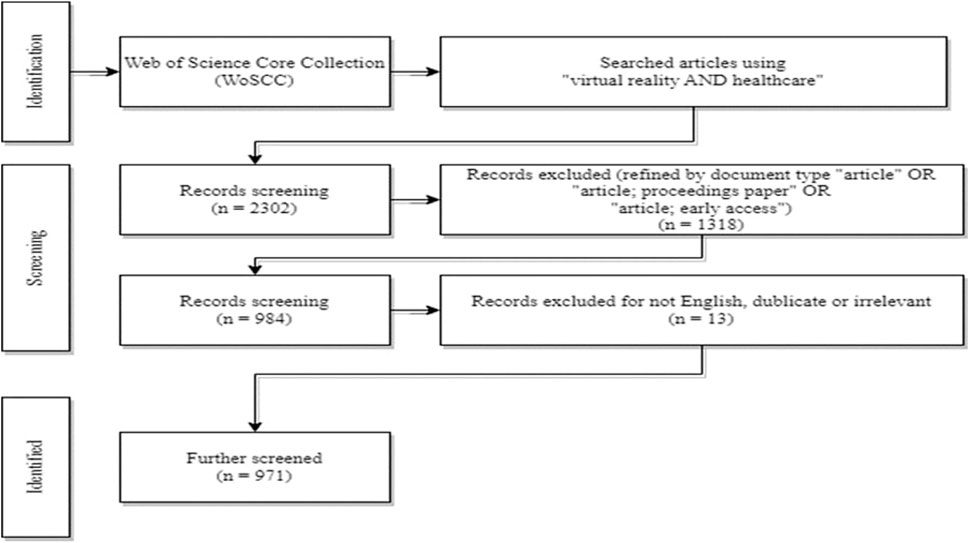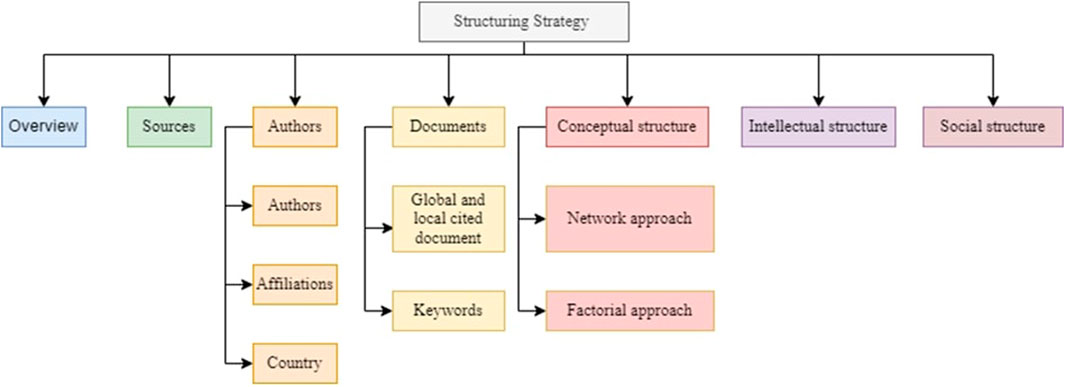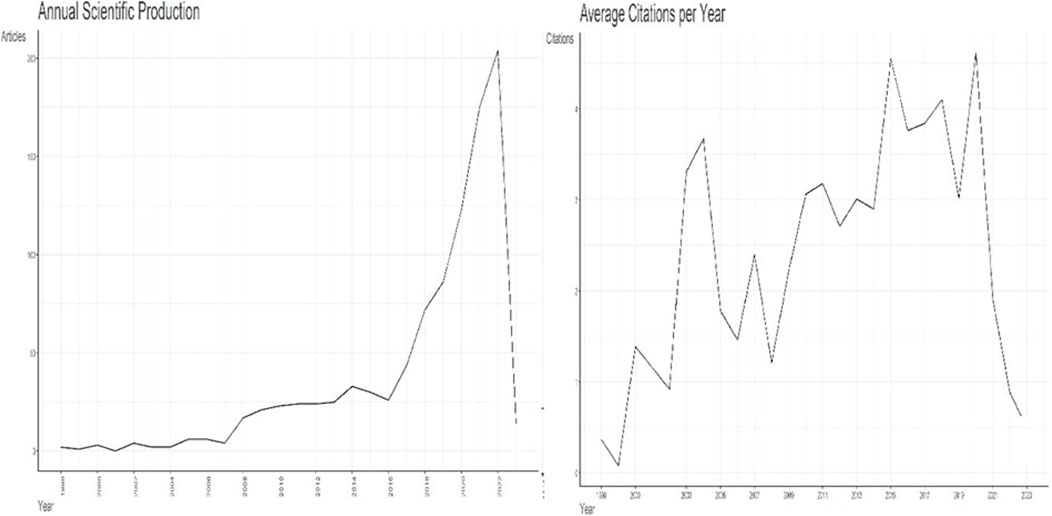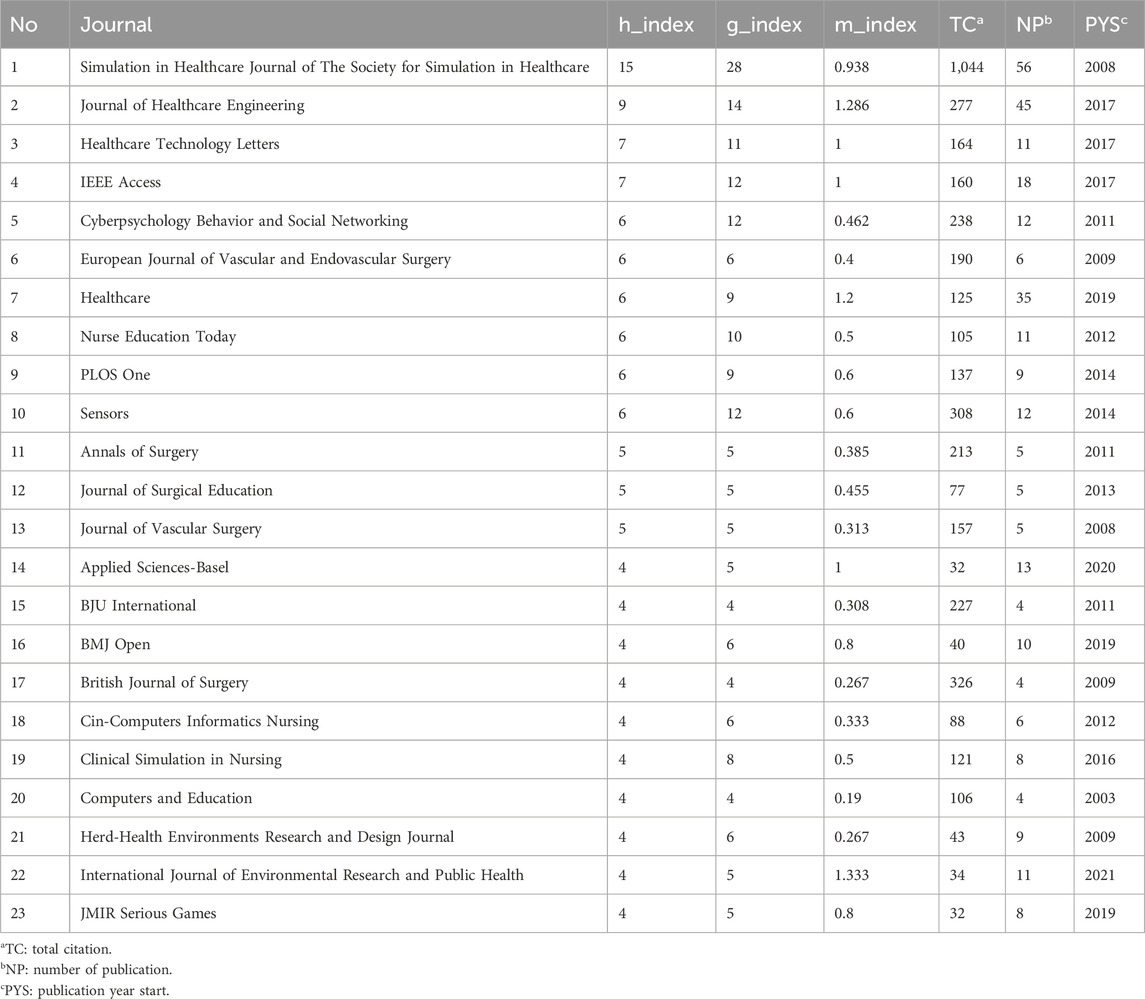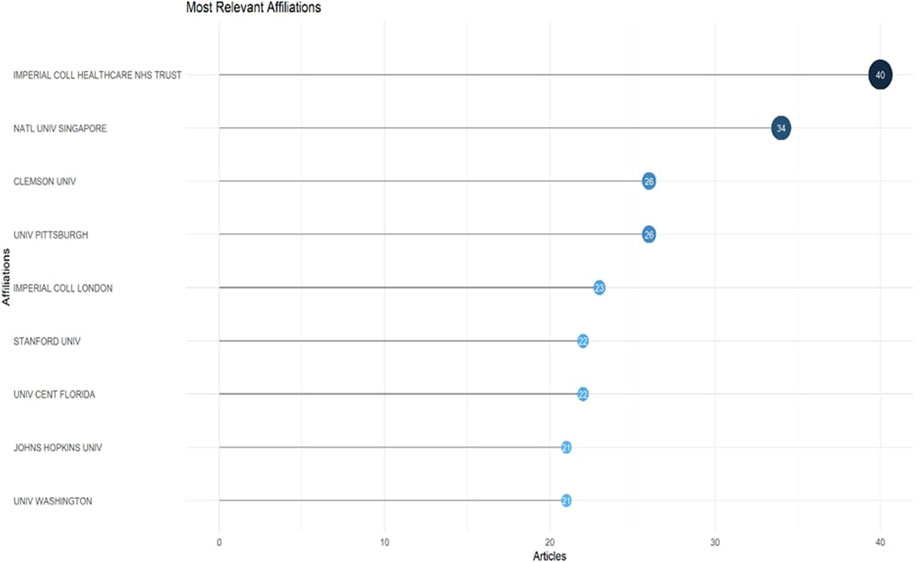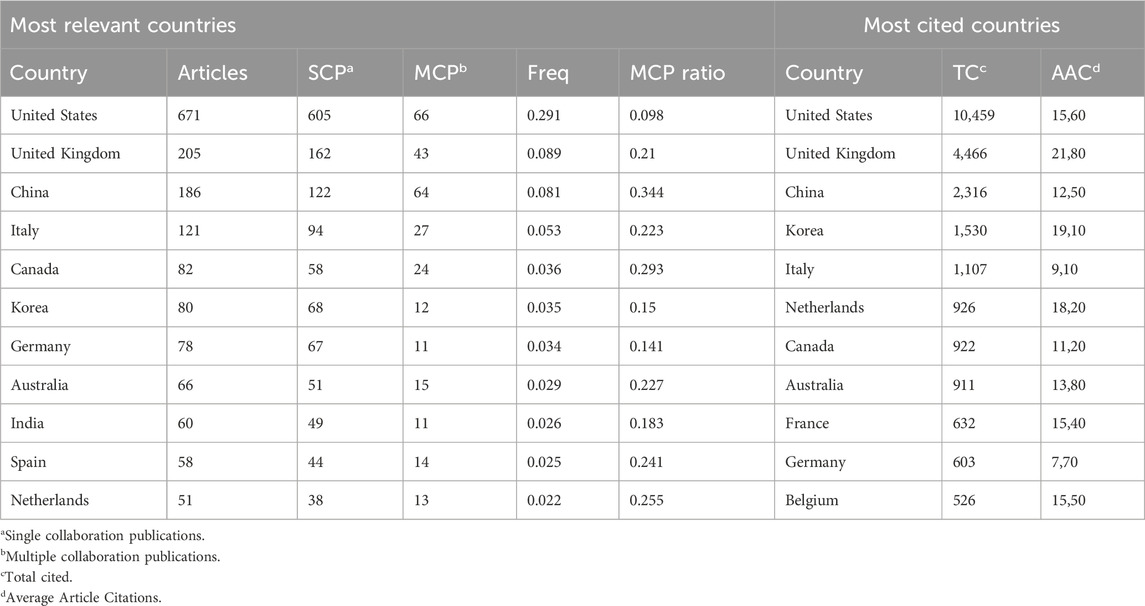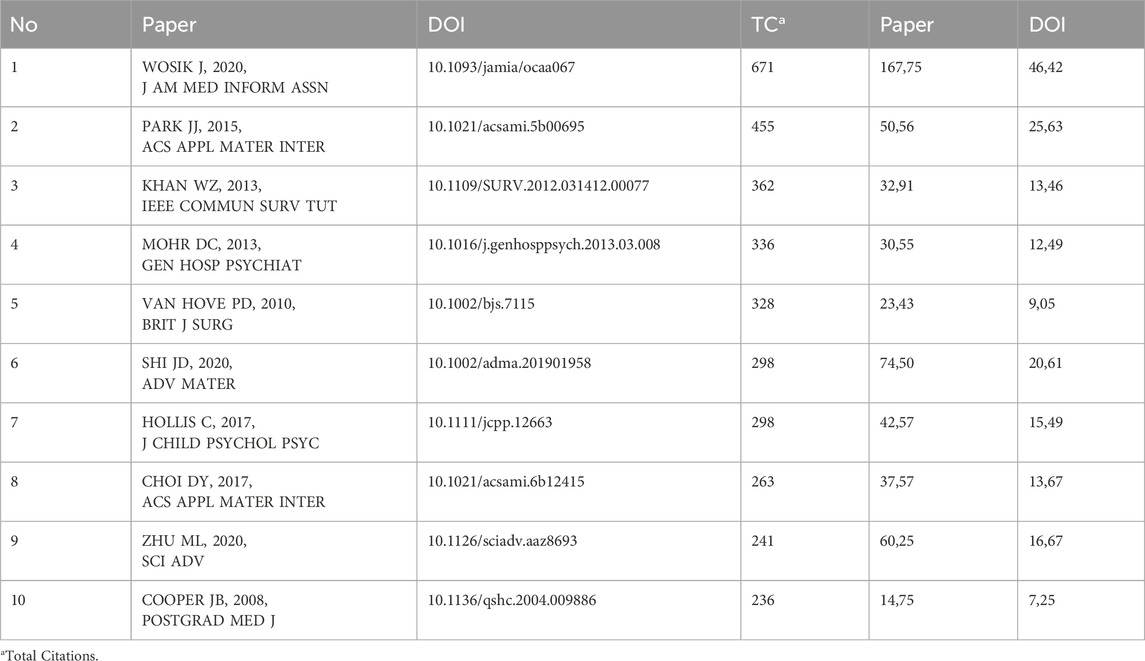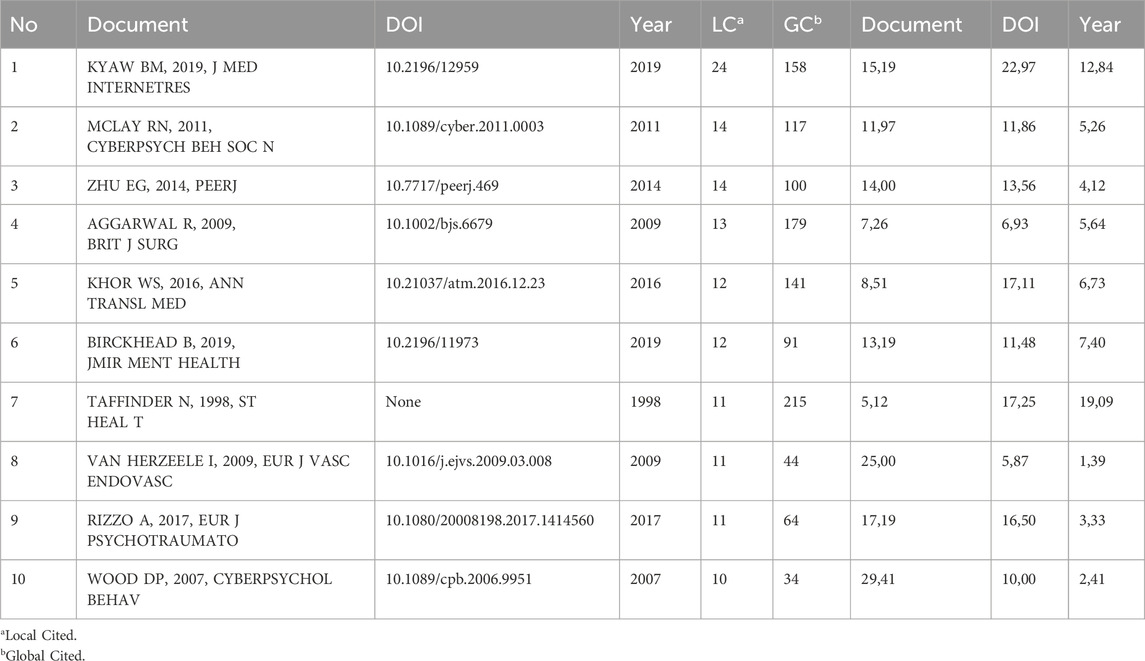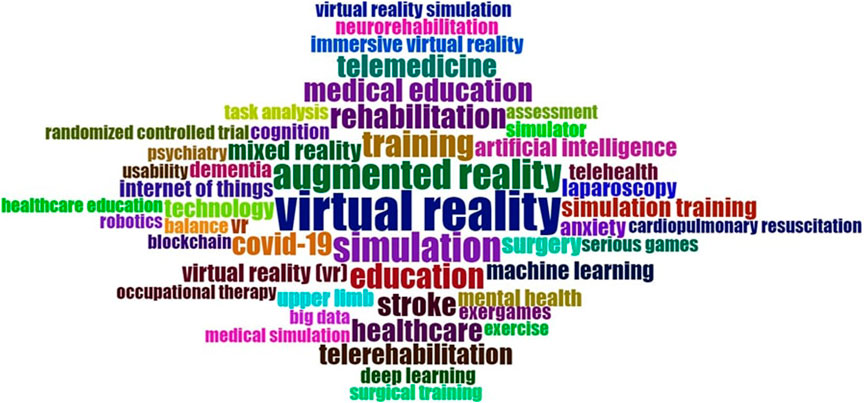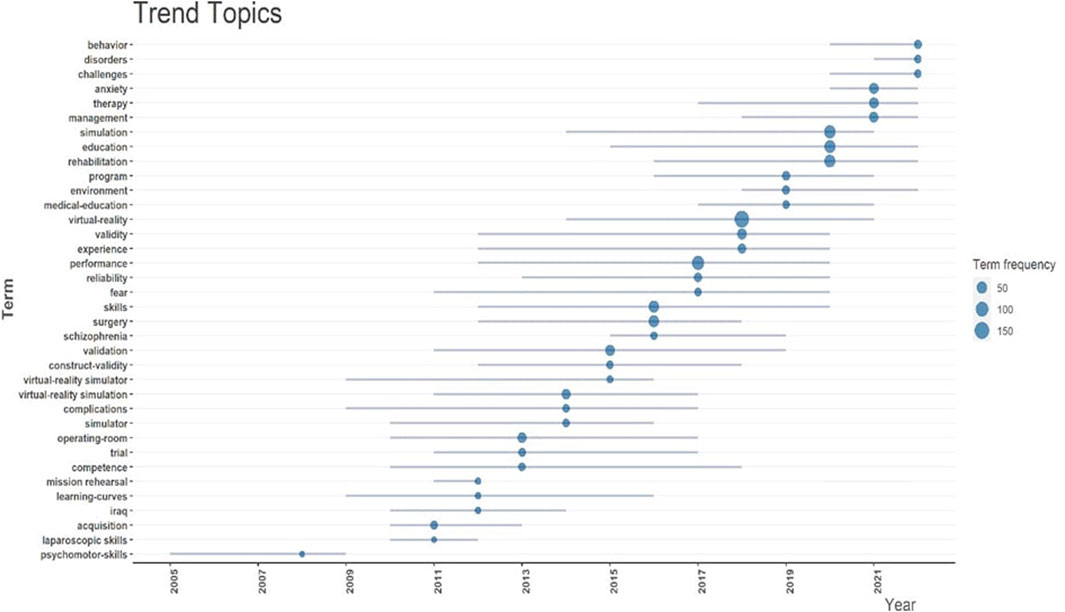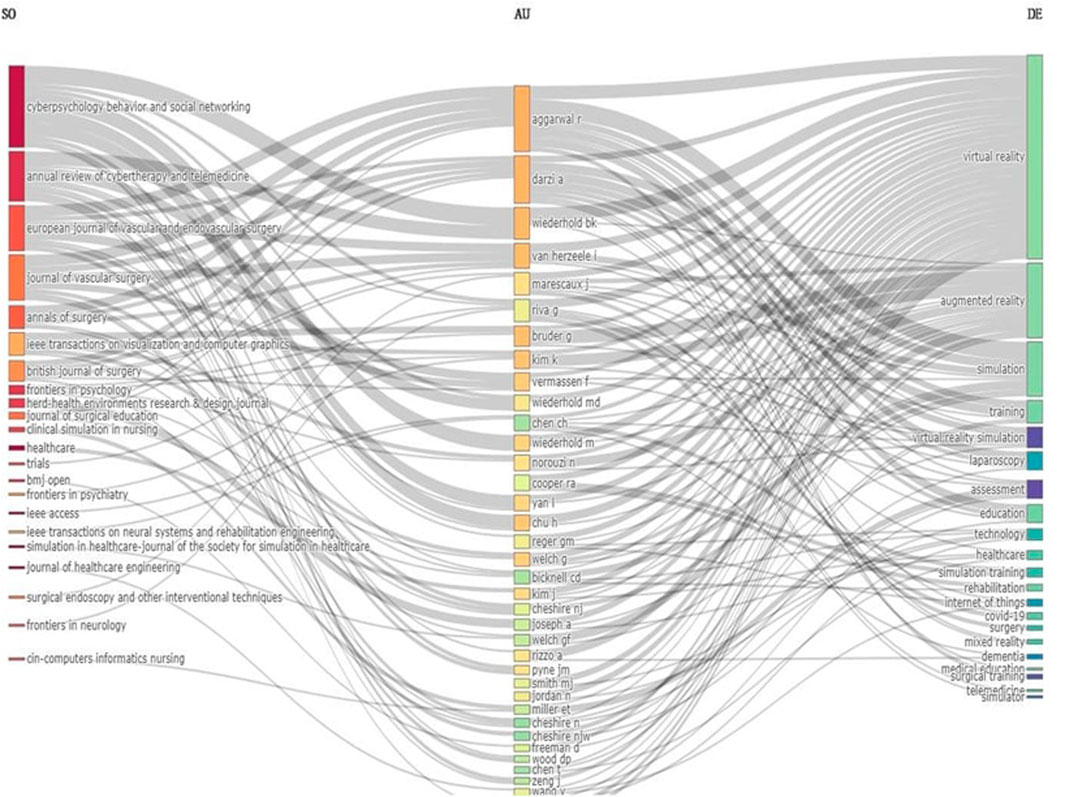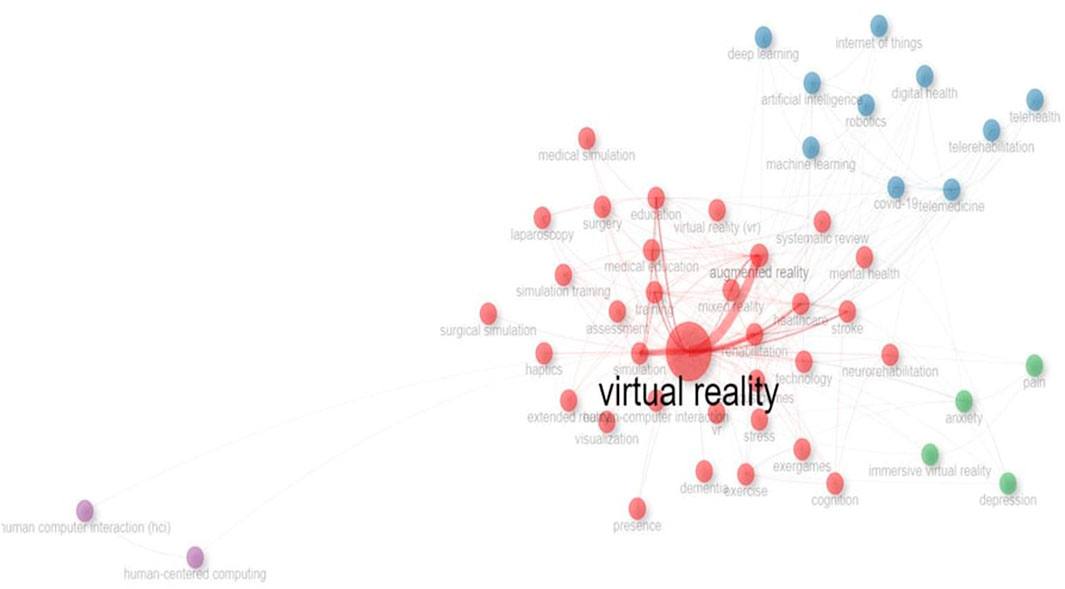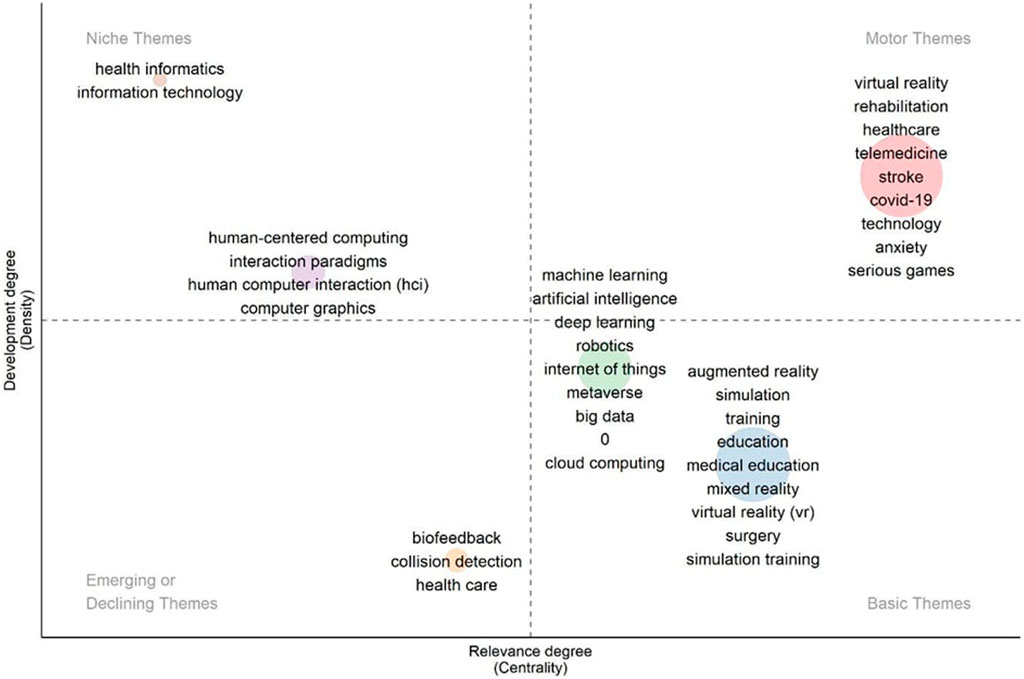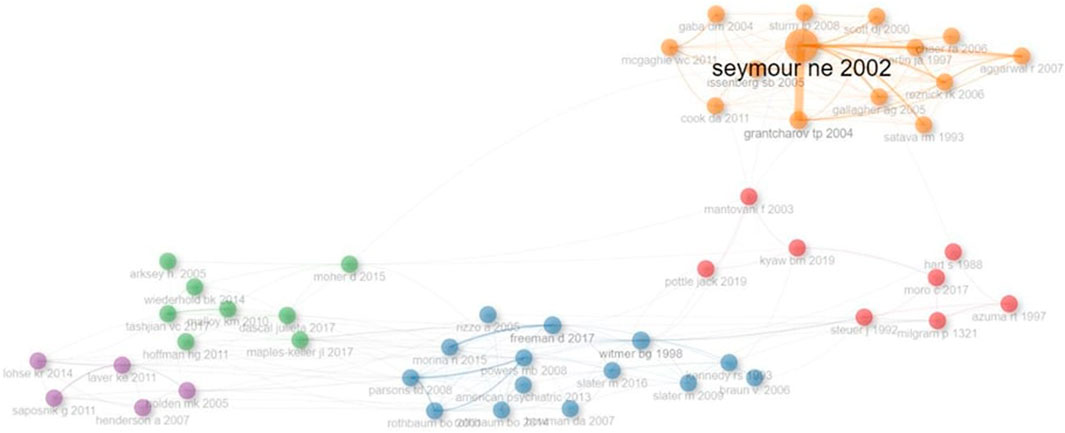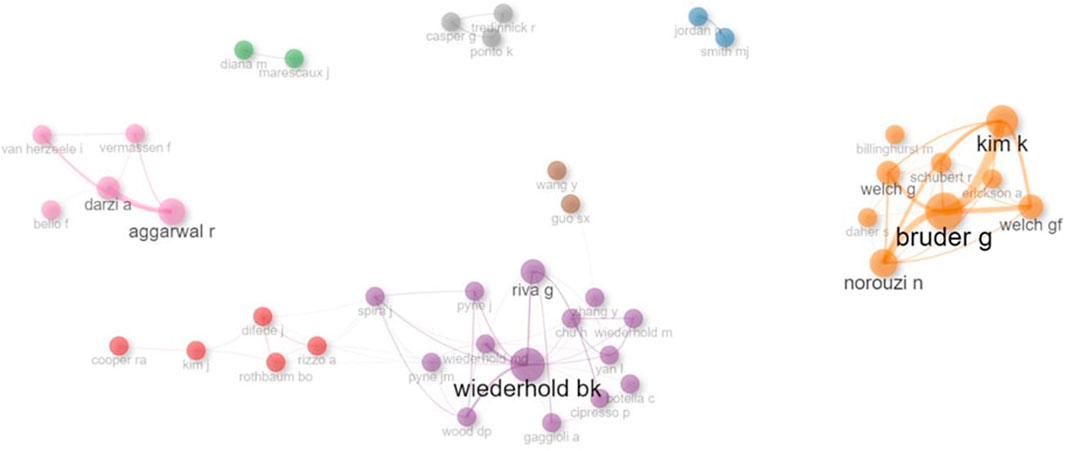- Department of Healthcare Management, Health Informatics and Technologies Program, Necmettin Erbakan University, Meram, Türkiye
Introduction: Virtual reality (VR) technology in the health field is used in processes such as rehabilitative services and therapy for patients, as well as increasing the training and capabilities of the workforce (doctors, nurses, etc.), which is an important factor in the provision of services.
Methods: This study combines quantitative and qualitative methods for a macro overview of the use of VR technology in healthcare. The database -Web of Science (WoS)- search for this study, in which bibliometric analysis was performed, was conducted in September 2023.
Results: A seven-stage structuring strategy was followed for the study findings. This allowed the analyses to be interpreted both independently of each other and in combination with different combinations. While most of the sub-information required for analysis through WoS is at an excellent or near-perfect level (15/16), one of the sub-information (1/16) is at an acceptable level. Although the first publication on the subject was published in 1998, researchers have frequently preferred it as a field of study since 2016. In Bradford’s Law, the number of publications in journals in Zone 1 corresponds to one-third of the total number of publications. In addition, the ratio of the number of publications of the 25 most influential authors in the field to the total number of author publications is similar. The year 2016 is a turning point for this issue. Since this year, the number of publications has increased significantly and the fields of study have started to evolve. Until 2016, simulation-oriented studies generally focused on simulations, and after this date, simulations have evolved into topics that directly affect human life, such as medical education, rehabilitation, therapy, or improvement of behavioral conditions.
Discussion: Research on the use of VR technology in healthcare has had strong growth in recent years. The existing contexts and possibilities underline that this field has the potential to attract more attention in the near future. Cross-sectional methods for implementation and simple ways to integrate VR into existing systems can be seen as what makes the technology so interesting and worthy of research. However, VR in healthcare also has some barriers, such as motion sickness, loss of sense of presence, eye strain, or inappropriate reactions in the real world.
1 Introduction
Virtual reality (VR) is a modeled 3D environment that allows individuals to experience and interact with environments, events, processes, or similar activities as they are perceived in the real world through their senses. 3D-modeled environments are created with various computer software (Slater and Sanchez-Vives, 2016; Freeman et al., 2017). These simulated environments are used using a variety of equipment such as headset devices (with mobile phones or not), computers, and high-tech cabinets. They also allow users to interact with the environment (Caponnetto et al., 2021). The software and hardware used for virtual reality can differ significantly from each other according to the reasons for their use and their technological level. However, as complicated as it may seem, it can be grouped under three basic categories. These are Non-immersive, Semi-immersive, and Full-immersive environments (Maranesi et al., 2022). The most important feature that distinguishes these three categories from each other is the freedom or restriction given by the equipment that users use while experiencing virtual reality to control the virtual world. In addition, the intensity of the interaction between the simulated world and their real senses is another important feature (Smith et al., 2012). As virtual reality technology has been increasingly integrated into diverse fields, including healthcare, it becomes essential to classify different types of VR experiences to better understand their applications and implications.
Each category is designed to fulfill a need. For example, the purpose of simulation can be simple spatial modeling such as designing a room or home decor. If this situation also allows limited control in the virtual environment using hardware such as a keyboard and mouse, it can be stated that a Non-immersive experience is experienced (Settembrini et al., 2018). Other areas where virtual reality technology is frequently used are airlines and militaries. The scenarios used in these sectors are scenarios, where users are more active and 3D visuals, are used more intensively than non-immersive technologies and scenarios. However, the user’s perception of the virtual world is still limited. These types of environments, which are especially used in the field of education and aim to both gain experience for individuals and reduce costs in some costly situations, are called Semi-Immersive applications (Salatino et al., 2023). Finally, fully immersive simulated environments are those in which the user is fully immersed in the virtual world, using the senses intensively, including sight, sound, and touch. Some studies include scenarios and content where smell is added in addition to these senses. In such a virtual world, the user can wear special equipment such as gloves, etc., and fully interact with the environment. In addition, in such scenarios, users have access to experiences such as free movement in both physical and virtual 3D environments. This is frequently used in healthcare scenarios to fulfill the daily exercise and movement needs of individuals with limited mobility who need to perform exercises, especially lower and upper limb movement (Mekbib et al., 2021; Lu, et al., 2023; Restout et al., 2023).
In the healthcare sector, one of the two sectors that form the foundation of most technological advancements, the preference for research related to VR technologies is steadily increasing among researchers, which is a market with an expected growth rate of over 25% between 2021 and 2030 and currently has a value of 5 billion USD (Global Data, 2023). It has been observed that such technologies in the field of healthcare are used in processes that include enhancing the skills and education of the workforce (doctors, nurses, etc.), which are essential factors in the delivery of healthcare services, as well as in rehabilitative services and therapy for patients (Wang et al., 2021; Mastropietro et al., 2016; Hartanto et al., 2015).
In today’s world, where technological development and change are expressed not on an annual but almost a monthly basis, and given the presence of a constant flow of intensive information from various sources, there has been a need to collectively and systematically bring together information such as researchers, institutions and the development and change process of the subject at the theme and sub-theme level in the literature on VR technologies in the field of health.
This study aims to conduct a comprehensive bibliometric and thematic analysis of VR applications in healthcare to identify key research trends, influential contributors, and emerging themes. By integrating both quantitative (bibliometric) and qualitative (thematic) analyses, this research provides a multi-dimensional perspective on the field. The bibliometric approach systematically maps the intellectual landscape by identifying high-impact publications, key authors, and research networks, while the thematic analysis delves deeper into the conceptual evolution of VR applications in healthcare, revealing how research themes have evolved over time.
Unlike traditional literature reviews, which may be subjective and limited in scope, this mixed-method approach enables an objective, large-scale assessment of scientific output while also capturing the nuanced thematic transformations in the field. Bibliometric analysis quantifies the impact of research contributions, while thematic analysis provides contextual insights that are crucial for understanding why certain research directions gain prominence. This combination is particularly valuable in rapidly evolving technological fields like VR, where identifying emerging trends and mapping knowledge diffusion can offer crucial insights for future research and policy development.
At the same time, this study makes several important contributions to the literature. First, it provides a comprehensive and up-to-date bibliometric and thematic analysis of VR research in healthcare, addressing the lack of large-scale systematic evaluations in the field. Previous reviews have often been limited in scope, focusing on specific applications (e.g., rehabilitation, surgery) rather than offering a broader perspective on VR’s interdisciplinary impact in healthcare.
Second, this study identifies emerging research trends and conceptual structures that have not been fully explored in earlier bibliometric studies. By mapping key research clusters and visualizing the evolution of VR applications over time, it highlights thematic shifts and underexplored areas, such as the integration of VR with artificial intelligence and its potential for mental health therapy.
Third, the findings provide actionable insights for researchers and policymakers by identifying core journals, influential authors, and dominant research networks. These insights can help guide future collaborations and research funding strategies, ensuring that resources are directed toward the most promising areas within the field.
The questions to be answered as a result of the study are as follows:
Research Questions (RQ):
RQ1: Which authors, institutions, and countries have actively participated in VR research about
Healthcare?
Answering RQ1 would enable researchers to identify international collaborations and potential
collaborators on VR research about healthcare. This would help explore the spatial distribution
of articles.
RQ2: What are the most important cited journals that constitute the knowledge field of VR
research about healthcare?
Answering RQ2 would be expected to facilitate scholars in finding suitable journals for publishing.
“healthcare and VR” related papers quickly.
RQ3: What are highly cited references in “healthcare and VR” related research according to
the number of citations?
Answering RQ3 would not only help researchers recognize significant documents, but also
reveal influential and productive countries, organizations, and authors that are internal
connected.
RQ4: What are the overall publication trends and subject categories in terms of publication output?
Answering RQ4 would help researchers explore the development trends and status quo of
“healthcare and VR” related research.
RQ5: What are the hot research topics and emerging trends discussed in “Healthcare and VR”
related papers?
Answering RQ5 would enable researchers to understand research domains and future directions clearly.
Several previous studies have employed bibliometric analysis to examine trends in medical technology research. For instance, Pawassar and Tiberius (2021) analyzed the evolution of VR applications in healthcare, identifying key growth areas and thematic shifts. Similarly, Kyaw et al. (2019) conducted a bibliometric review focusing on digital health education, highlighting how emerging technologies such as virtual reality and artificial intelligence are reshaping medical training. These studies provide a foundation for understanding the research landscape; however, our study expands on their findings by offering a more comprehensive, up-to-date, and multi-dimensional analysis that integrates both bibliometric and thematic perspectives.
Moreover, bibliometric studies on medical technology trends, such as those by Falagas et al. (2008) and Martín-Martín et al. (2020), have demonstrated the increasing significance of data-driven evaluations in identifying influential researchers, journals, and collaboration networks. By incorporating a similar approach, this study aims to provide a structured and in-depth understanding of the research evolution in VR applications within healthcare.
2 Materials and methods
2.1 Data collection and search strategy
Web of Science Core Collection (WoSCC) is one of the most widely used scientific databases in literature searches. Many researchers have conducted studies examining the data coverage, journal quality, advantages, and disadvantages of WoSCC (Martín-Martín et al., 2020). Hou et al. (2015) state that WoSCC provides data necessary for bibliometric analysis, such as the number of cited references, affiliation, DOI, keywords, and keywords plus, in a more standardized and comprehensive manner compared to other databases. Furthermore, in terms of high-level visualization, studies conducted by Falagas et al. (2008) and Gan et al. (2022) have indicated that WoSCC is the most suitable database. For these reasons, the WoSCC database was preferred for the literature review in this study.
The database examination and bibliometric analysis were conducted in December 2023. In the conducted search, the database included “all fields” searches, and the keyword selection was defined as “Virtual Reality AND Healthcare” as well as “VR AND Healthcare”. This study included “article,” “article, early access,” and “article, proceedings paper” publications. In this study, only English-language literature was used to ensure universality and to maintain consistency in terms of keywords, keywords plus, and similar data. During the screening process conducted by authors, articles were excluded from the study based on titles, abstracts, and, if necessary, the full text, following a thorough examination. The final set of studies was obtained in September 2023.
To ensure a rigorous and systematic selection process, the study applied well-defined inclusion and exclusion criteria. Publications were excluded based on the following conditions:
1. Scope Misalignment: Studies that did not explicitly focus on VR applications in healthcare (e.g., general VR technology development without medical context).
2. Lack of Empirical or Review-Based Content: Editorials, opinion pieces, conference abstracts, and studies without substantial methodological or empirical contributions.
3. Language Barrier: Only studies published in English were included to maintain consistency in keyword analysis and metadata extraction.
4. Duplications and Redundancy: Duplicated entries, retracted papers, and studies that did not provide unique contributions were removed.
The selection process was carried out in multiple stages. Initially, a title and abstract screening was conducted to filter out irrelevant papers. Following this, a full-text review was performed independently by two researchers to ensure consistency in inclusion and exclusion decisions. Any discrepancies were resolved through discussion and consensus, ensuring that only methodologically sound and thematically relevant studies were included in the final dataset.
After the keyword search, a total of 2,302 publications were identified. Out of these publications, 1,318 were excluded because they were not “article,” “article, early access,” or “article, proceedings paper,” and an additional 13 were removed due to language issues, duplication, and relevance to the topic. Therefore, the study was conducted with a total of 971 publications. The data collection methodology used for scientometric analysis is illustrated in Figure 1.
The Bibliometrix (Aria and Cuccurullo, 2017) library in the R Studio IDE was utilized for analysis. Since WoSCC allows the download of a maximum of 1,000 plain text files, the files were downloaded multiple times and the necessary transformation and merging processes were carried out using R Studio’s XLSX library. The single file obtained was later analyzed using the Bibliometrix package, considering various characteristics as part of the study.
2.2 Structuring strategy of the research
The study was structured following a specific systematic pattern. The analysis of the study was conducted under six main headings, and the structuring strategy for the main headings and subheadings is illustrated in Figure 2.
3 Results
3.1 Analysis of metadata outputs
The missing data for the descriptive characteristics of the included metadata in the study is presented in Table 1. According to this, it appears that most of the studies do not have missing data, especially for basic descriptive characteristics. Additionally, the lowest value considered acceptable for conducting bibliometric analysis appears to be met. The mentioned “acceptable” value pertains to missing DOI (DI) numbers in the publications obtained from WoSCC. Therefore, this bibliometric study, will not lead to any distortion or deficiency in terms of analysis and findings.
In Table 2, which displays descriptive statistics, it can be observed that the first publication meeting the specified keywords in the database dates back to the year 1998. There are a total of 971 publications across 499 sources. The annual growth rate of publications related to the subject is 8.09%. The 971 included studies were authored by 4,909 researchers. Additionally, 29 researchers have individually worked on the topic and published their work. The international collaboration rate among authors in the publications is 27.09%.
In the local dataset of 971 studies, it is observed that research focusing on the use of VR technology in healthcare services became a notable area of study as of 2016. The annual average citation count related to the topic varies by year but generally shows an increasing trend (Figure 2).
3.2 Analysis of sources’ output
This section provides quantitative data related to the journals in which studies on the subject have been published. The literature suggests that in determining the journals that are active in the field based on the method used (bibliometric analysis), not only the total number of publications published on the subject but also the outputs of Bradford’s Law should be evaluated (Brookes, 1968; Brookes, 1977).
Bradford’s Law is a concept that describes the distribution or scattering of literature in specific subjects across journals (Garfield, 1980). Hertzel (1987) expresses this situation as follows:
“If scientific journals are arranged in descending order of efficiency of articles published on a particular subject, the journals may be divided into a core group of journals that publish articles exclusively on that subject, and several groups or regions containing the same number of articles as the core group”.
In this study, the ranking according to the number of articles published in the journals related to the subject is compatible with the journal lists in Zone 1 according to Bradford’s Law rule. In other words, the effective journals in the field related to the topic are those listed in Figure 3.
Table 3 provides data on the h-index, g-index, and m-index scores for the top 23 journals in Zone 1 according to Bradford’s Law, which is considered the most influential in the academic field related to the subject. The ranking of journals is based on their h-index scores.
The 23 journals listed in Table 3 as the most influential journals in the field make up 31.60% of the total publications (n = 971) in the study dataset, with a total of 307 publications related to the topic. The top three journals, Simulation in Healthcare Journal of The Society For Simulation in Healthcare, Journal of Healthcare Engineering, and Healthcare Technology Letters, with a total of 112 publications, account for 36.4% of the publications in the specified 23 journals. When examining the number of citations, it is observed that the top three journals account for 35% of the total citations received by the 23 journals. Based on the assumption that an increase in the number of published articles leads to an increase in the number of citations, it can be stated that the average number of citations per article for the top three journals is 18.64, 6.15, and 14.90, respectively. The average number of citations per publication for the entire study was calculated at 16.90, as indicated in Table 2.
3.3 Analysis of authors’ output
This section contains the authors’ output regarding the analysis results. Within the section, the authors’ outputs are presented under the subheadings of a) authors, b) institutions to which the authors are affiliated, and c) countries of the authors.
3.3.1 Authors output
Publications related to the subject have been authored by a total of 4,909 authors (Table 2). Quantitative data such as impact scores, publication numbers, and citation numbers of the top 25 influential authors in terms of subject are included in Table 4.
According to the h-index ranking, the top 25 influential authors in the field have a total of 197 publications related to the topic. The top three authors, with a total of 56 publications, account for 28.42% of the total publications. Furthermore, the top three authors, with a total of 2,144 citations, make up 39.22% of the total citations received by all authors listed in the study (n = 5,466). Although there are five authors in the field with a publication count exceeding 10, it is observed that in the ranking based on h-index scores, Wiederhold, BK. and Bruder, G. are listed as eighth and ninth, respectively, despite having more than 10 publications. Besides, it can be stated that the most influential three authors are Aggarwal, R., Darzi, A., and Van Herzeele, I. Further analysis results, including the subfields preferred by the authors and their collaborations, are presented in the following sections.
3.3.2 Affiliations output
The most influential institutions to which the authors are affiliated, with publication counts exceeding 20, are provided in Figure 4.
It is observed that there are nine institutions with more than 20 publications related to the use of VR technology in healthcare services. In the local dataset, which includes a total of 971 publications, the rate of articles published by these nine institutions (n = 235) is 24.20%. The most influential institution in the field is Imperial College Healthcare NHS Trust, which collaborates with Imperial College London in the United Kingdom. It is followed by the National University of Singapore and Clemson University based in the United States. Additionally, Imperial College London is among the top nine institutions in terms of publications, both in collaboration with other institutions and through its own publications (Figure 5).
3.3.3 Country output
This section examines the countries where the corresponding authors are located. It is observed that influential authors in the field are primarily located in three countries (Table 5). In terms of productivity, the United States (United States) has the most publications. The United States also dominates other countries by covering 69.1% of the 971 publications in the local dataset. Out of the 671 articles published in the United States, 605 of them have contributed to the field through multiple collaborations (multi-authored), while 66 articles were published by single authors. As expected, the United States is also in the lead in terms of total citation counts with 10,459 citations. For both variables, the United States (United States) is followed by the United Kingdom (UK) and China. However, when the average article citations are examined, it is noteworthy that although the United States dominates the field in terms of the number of publications, the United Kingdom has a six-point difference over the United States with an average of 21.80 citations. So publications in the UK either serve as foundational works for subfields within the field and are cited by other researchers or innovative works, both of which can lead to a higher number of citations.
The reason why NATL UNIV SINGAPORE (34) is ranked second in the list of institutions producing the most publications on the subject, yet Singapore is not included in Table 5, which lists the countries with the highest number of publications and citations, is that the threshold for inclusion was set at a minimum of 50 publications per country and a minimum of 500 citations per country.
3.4 Analysis of document output
This section evaluates only the most influential articles in the field regardless of the author and country. Following the first article published in 1994, these articles published on the subject, which has become a systematic area of interest in the following years, serve as important resources for the authors. This section is structured into two subsections: one is articles and the other one is keywords. In the first section, there is information about the most frequently referenced articles in the literature and the most influential articles referenced in the local dataset, including details about the journals they were published in, total citation counts, and citation counts per year (Tables 6, 7).
3.4.1 Most global and local cited document output
In bibliometric analysis, locally cited documents refer to studies that are frequently cited within the dataset of this study, indicating their influence within the specific research domain of VR in healthcare. On the other hand, globally cited documents represent highly cited papers across all fields, demonstrating broader academic recognition beyond this research niche. By distinguishing these two categories, we can identify both foundational works within our dataset and globally recognized influential studies that shape the research landscape. The most cited publication in the general literature by Wosik et al. (2020) is an article titled “Telehealth Transformation: COVID-19 and the Rise of Virtual Care” (Table 6). The annual average number of citations of this publication is 167.75 while in total 671.
Indeed, Table 6 is important as it provides a list of sources that contribute intellectually to the field. Table 7 provides information about the top 10 most cited articles in our dataset, but it also includes data on how frequently these articles reference each other among the 971 publications. The article titled “Virtual Reality for Health Professions Education: Systematic Review and Meta-Analysis by the Digital Health Education Collaboration,” authored by Kyaw et al., in 2019 holds a prominent position as the most referenced and influential publication within the local dataset. It is observed that out of the 971 articles in the dataset, 24 have received citations. Globally, the total number of citations received is 158.
3.4.2 Author’s keywords output
Keywords are often words or phrases that provide a concise summary of a paper’s abstract, allowing readers to quickly grasp the content at a glance. Selecting appropriate keywords that adequately describe the content and align with the subject matter is an important criterion for an article. In this section, data is presented on commonly used keywords in the local dataset of articles and how keyword trends have changed over the years, that is, which subfields within the subject have gained prominence over the years.
As evident from the word cloud, many keywords are preferred in different fields related to health services, especially “virtual reality”, which form the basis of the subject of the study, and therefore the literature is enriched in line with these keywords. Figures 6, 7 provide data on how researchers have associated the topic with different subtopics over the years, offering insights into intellectual contributions and author trends related to the subject matter.
Considering that the breakdown in the density of researcher publications on the use of VR technology in the field of health services has occurred since 2016 and has gained remarkable momentum as of this date (Figure 2), it will be useful to evaluate the preferences in keyword selection in two parts, before 2016 and after 2016. Before 2016, researchers were generally simulation-focused, but after that date, the simulations were more often related to areas directly affecting human life, such as medical education, rehabilitation, and therapy, or improving behavioral conditions. This suggests that the literature’s foundation, which had been ongoing until that time, is now used in a way that can directly and positively impact human life.
The Sankey diagram above illustrates the active authors (AU) in the field, the keywords (DE) frequently used by these authors, and the active sources (SO) in the field (Figure 8). This diagram provides a concise overview of the relationships between the sources, authors, and keywords that have been discussed in the analysis so far, without going into detail. However, the diagram does not show the most influential variables independently in each subsection (DE, SO); instead, it presents the keywords frequently preferred by these authors and the journals to which the authors submit their articles in an author-centric approach.
The thickness of the connections in the diagram, which represents the relationship between the authors, their choice of keywords, and the journals where their articles are published, indicates the intensity of the relationship. Accordingly, it can be observed that prominent authors in the field, such as Aggarwal, R., often prefer journals like the Journal of Vascular Surgery or Annals of Surgery with keywords like “virtual reality,” “simulation,” and “augmented reality”.
3.5 Analysis of the conceptual structure
In this section, the conceptual analysis of the subject is given. The analysis was carried out on words blended from the titles and keywords of the articles, which are referred to as keywords plus.
The conceptual structure map (Figure 9) groups research themes into distinct clusters, representing co-occurring research areas. The presence of tightly interconnected clusters indicates well-established research domains, whereas more dispersed clusters suggest emerging or niche topics. For instance, the cluster around ‘VR-based training’ and ‘simulation’ is highly dense, demonstrating a mature and extensively researched area. In contrast, the cluster containing ‘mental health’ and ‘VR for therapy’ is more dispersed, indicating an emerging research domain with ongoing development. This structure highlights the field’s progression from technological advancements to patient-centered applications.
Thematic mapping is a mapping method that shows the past and present flow of the academic field related to the subject (Figure 10). This method is based on four main categories and centralization of the subject is influenced positively or negatively as we move to the right or left. Movements from bottom to top show an increase or decrease in the intensity of studies on the subject. Basic themes are defined as the concepts that form the basis of a subject. Themes such as VR, training, education, and medical education were included in this area as a result of the analysis.
Motor themes are current and trending research topics. Keywords in this field such as rehabilitation, telemedicine, COVID-19, and anxiety indicate popular research topics trending today and are preferred by researchers more than others. In particular, the keywords ‘anxiety’ and ‘rehabilitation’ suggest that the subject is now extensively studied by researchers in fields such as psychology and similar disciplines.
Niche themes refer to situations where the subject is studied in a specific and narrow area. Keywords such as ‘human-centered computing’ and ‘computer graphics’ in this category align with the field’s description, indicating a focus on technical areas like science and engineering rather than social or health sciences.
Emerging or declining themes refer to trends that are either fading away or gaining popularity in the subject. These research areas provide insights into the future of VR technology. For example, it is observed that this technology is used in biofeedback therapies, minimizing issues encountered in previous treatments such as low motivation for treatment, difficulties in applying learned skills to real life, or distracting elements during treatment (Lüddecke and Felnhofer, 2022). Collision detection, which also allows design to be tested in fields such as engineering, architecture, or manufacturing, refers to the collision that occurs between two virtual objects in the three-dimensional world. The reasons why researchers prefer this keyword specifically on the subject may be situations such as healthcare personnel training, for example, it may have taken place in research on virtual surgeries to be performed by physician candidates with VR or extraction and similar procedures in scenarios prepared for dentists.
The words expressed as keywords plus are important in interpreting not only the region they are in but also the neighboring region they approach.
3.6 Intellectual structure
This section analyzes the intellectual accumulation related to the subject and its structure. This analysis refers to the articles’ centrality positions and academic power structures. They, also referred to as intellectual schools, are resources that help researchers in shaping the field. These schools, which support the field intellectually, cover not only the local data set but also the literature in the bibliographies of the data set. In other words, they can be described as schools of thought that contribute to the development of the main idea and research areas in the field.
According to the data presented in Figure 11, it is possible to say that five schools of thought (orange, red, blue, green, purple) have played a leading role in the formation of the field and support for new research areas. Among these five schools, the orange and blue schools are the ones with the highest author participation and the most intensive relationship networks. Seymour NE, one of the representatives of the Orange School, and related authors seem to be more interested in VR training in the field of surgery (especially laparoscopic). These writers also belong to one of the two groups with the most intense and productive writers. Kyaw BM, one of the representatives of the Red School, and its representatives have carried out studies on the training of health professionals in the theoretical field other than practice with VR. Representatives of the blue school, including Rizzo Albert and similar researchers, focus on therapeutic methods and VR applications related to mental health disorders. They belong to the second group with the most intense author relationships, alongside the orange group. The green group, represented by Wiederhold BK and related authors, has worked more on topics such as metaverse games and virtual healing (VR for pain management). Finally, the purple group, which includes authors like Lohse KR and Holden MK, has focused more on the psychological aspects of the subject, conducting research on the use of VR for anxiety reduction and therapy. It can be stated that these groups, which are seen to have frequent and intense relations within themselves, have weak relations with external stakeholders.
3.7 Social structure
This section describes the frequency of collaboration among researchers and the relationships between authors based on their institutions or countries and reveals how often authors work with each other.
Examining the social network structure created by groups of two or more authors, it is observed that the writers are included in eight network structures. The authors at the center of the network structures are distributed similarly to the authors in the intellectual structure mentioned in Section 3.6. However, a smaller number and lower level of authors are also involved. Examining the studies of these authors, it is seen that their studies are related to technical subjects in engineering and engineering sciences rather than scenarios. In particular, authors in the yellow group work together intensively, meaning that the frequency of their collaborative work is high. A similar situation can be observed for authors in the purple group (Figure 12).
4 Discussion
This study examines the literature on VR technology in the field of healthcare on publication groups, authors, articles, conceptual structure, and intellectual structure. It is seen that 2016 is a milestone in preferring the subject as a field of study. In a similar study conducted by Pawassar and Tiberius (2021), it was stated that there were 255 publications between 2016 and 2021 (April), which is much more than before 2016 (Pawassar and Tiberius, 2021). If this study is limited by year, it is seen that 666 more articles were added to the literature between 2021 and 2023. These data are important in proving that the subject has been a trending topic for researchers in recent years. The findings of this study indicate a significant shift in VR research trends in healthcare, particularly after 2016. Instead of merely observing the increase in publications, it is essential to understand the driving forces behind this surge. One key factor is the rapid advancement of VR hardware and software, making the technology more accessible and cost-effective for researchers and healthcare practitioners. Additionally, increased funding for digital health innovations has facilitated the integration of VR into clinical applications. The growing emphasis on patient-centered care has further contributed to the rise of VR-based rehabilitation and mental health interventions, as these technologies offer immersive and interactive therapeutic experiences. Moreover, the clustering analysis suggests that certain research themes have evolved significantly over time. For instance, the transition from early VR applications focused on surgical simulations to more recent developments in VR-assisted rehabilitation and cognitive therapy indicates a shift toward patient-oriented implementations. This thematic evolution reflects broader changes in healthcare priorities, where technology is increasingly leveraged to enhance patient outcomes and accessibility.
The significant increase in VR-related healthcare research after 2016 can be attributed to multiple interrelated factors:
1. Technological Maturity and Accessibility: The rapid commercialization of consumer-grade VR devices (e.g., Oculus Rift, HTC Vive) significantly lowered costs and increased accessibility, facilitating more extensive research applications in medicine (Slater and Sanchez-Vives, 2016). This development enabled a broader exploration of VR-based medical training, therapy, and rehabilitation (Maraj et al., 2019).
2. Policy and Funding Initiatives: Government agencies and private foundations have significantly increased funding for digital health innovations. For example, the U.S. National Institutes of Health (NIH) and the European Commission have invested heavily in VR-related medical applications, particularly in pain management and neurorehabilitation (Stoumpos et al., 2023).
3. Integration with Artificial Intelligence and Data Science: The convergence of VR with AI and machine learning has enabled more personalized and adaptive VR therapies, particularly in cognitive rehabilitation and mental health applications (Mazzolenis et al., 2024). AI-driven real-time adjustments in VR environments have improved patient engagement and outcomes.
4. The Impact of the COVID-19 Pandemic: The global pandemic accelerated the adoption of VR in telemedicine, remote patient monitoring, and virtual medical education (Wang et al., 2024). This shift was particularly notable in the increased use of VR for surgical simulations, mental health therapy, and physical rehabilitation.
The top three influential researchers in the field are Aggarwal R., Darzi A., and Van Herzeele I. In this study, the effectiveness levels of the authors were determined based on the h-index scores of the researchers. Pawassar and Tiberius (2021) based this ranking on the number of publications of the researchers, and the top three authors were reported as Riva G. (9), del Piccolo (6), and Schwebel DC (6). When a similar ranking was conducted in this study, the top three names differed, likely due to the additional time allowing researchers to publish more. In 2023, the most productive authors in the field, based on the number of publications, are as follows: Aggarwal R. (25), Darzi A. (17), Wiederhol BK. (17). Examining the social structures formed among these authors, it is observed that Aggarwal R. and Darzi A. have established a social network within themselves, and a similar relationship exists between Wiederhol BK. and Riva G. Likewise, the social structure between Bruder G. and Kim K. is also noteworthy among the relationships in the field’s publication productivity. Probably, every researcher who has studied or is studying on the subject has come across more than one of these authors’ studies. Examining the institutions that contribute academically to the field, Imperial Coll. Healthcare NHS Trust (England), National University Singapore (Singapore), and Clemson University (United States) are the most productive institutions. The United States, United Kingdom, and China dominate the field in the country’s specific productivity. These three countries are also leaders in terms of the number of citations.
Journal of The Society for Simulation in Healthcare is one of the leading journals that nourish the field specifically on the subject. Another influential source is the Journal of Healthcare Engineering. Statistically, one out of every ten publications is published in one of these two journals. Therefore, researchers studying on topic would benefit effectively from these journals. In their study, Pawassar and Tiberius (2021) have found the most influential journals the Journal of Medical Internet Research, JMIR Serious Games, and Games for Health Journal. It is observed that the sources that nourish the literature of the field have changed in the past 3 years.
There are only five articles worldwide with 300 or more citations on the topic. One of these articles was published in 2020, one in 2015, two in 2013, and the other in 2010. Examining these articles, it is observed that VR technology is frequently used for remote patient care, surgical intervention training, rehabilitation, or therapy scenarios. The most highly cited study on the use of VR technology in healthcare was conducted during the COVID-19 period, focusing on Telehealth during the COVID-19 pandemic and virtual care (Wosik et al., 2020). Examining the most highly cited studies from the local dataset, it is again observed that studies predominantly revolve around areas such as therapy, medicine, or healthcare profession education. There are five articles exceeding 100 global citations. Four of these are related to surgery, healthcare education curriculum, and similar healthcare education topics, while one is related to exposure therapy in psychology. From this perspective, it should be noted that scenarios created with VR are frequently preferred in healthcare education. Compared to traditional education methods, there are many studies indicating that VR-based education is more effective (Eppich et al., 2011; Plotzky et al., 2021; Chen et al., 2023; Morrow et al., 2023). Moreover, some studies demonstrate the effectiveness of VR-based education compared to modern forms of education such as online/offline digital education. These studies provide evidence that healthcare professionals improve knowledge and skill outcomes in post-training interventions. There are also results regarding the attitude, behavior, and cost-effectiveness of interactive VR technology (Kyaw et al., 2019; Ahuja et al., 2023).
The beginning period of significant change in terms of the diversity of research areas was marked by the year 2016 and onwards, igniting new trends in the field. This, in turn, led to a more frequent and diverse transformation of research areas related to the subject. Prior to 2016, research trends generally focused on simulators and simulation development, aiming to create scenarios that would be more realistic and have a minimal margin of error for future work. After 2016, there has been a noticeable shift towards using these simulations to improve surgical skills, enhance individual performance and experience, deliver applied education in fields like medicine and healthcare, as well as provide administrative and managerial training. In recent years (2020 and onwards), it is also evident that studies have predominantly focused on the treatment of psychological disorders and therapies. Pawassar and Tiberius (2021) categorized trend topics of 2021 into three main categories. The first category includes studies related to communication and VR interaction (such as patient-caregiver interactions and communication training). The second category comprises research on telemedicine and VR integration for the development of medical professionals. Finally, the third category encompasses studies on physical activities for both young and elderly individuals.
It is possible to categorize the research topics in the field into four main groups without a year constraint: basic topics, hot topics, niche topics, and emerging topics. Research areas directly related to the field, such as augmented reality, simulation, training, education, and virtual reality, fall into the basic topics category. Research topics including machine learning, artificial intelligence, the Internet of Things (IoT), rehabilitation, COVID-19, and anxiety are among the trending topics frequently preferred in recent years. In the healthcare services domain, research areas like health informatics, human-centered computing, and interaction paradigms are highly specific and technical topics in niche areas. Furthermore, in the coming years, we may frequently see healthcare-VR-related studies in the literature that include more realistic training stages thanks to biofeedback treatment processes and collision detection sensitivity. The thematic clustering analysis in this study indicates a clear transition in VR research focus over the past decade. Early research predominantly centered on technical feasibility and hardware development, whereas more recent studies emphasize patient-centered applications and clinical effectiveness.
• The emergence of VR-based rehabilitation and cognitive therapy as dominant themes reflects a paradigm shift from purely simulation-based applications toward direct patient care solutions.
• The increasing connectivity between “VR therapy” and “mental health” topics suggests that VR is becoming a mainstream tool for psychological interventions, moving beyond its traditional use in physical rehabilitation.
• The convergence of research clusters around VR and AI integration indicates a growing interest in adaptive, data-driven VR interventions. These findings highlight an ongoing shift in VR research priorities, aligning with broader trends in precision medicine and personalized healthcare.
The thematic clustering analysis in this study indicates a clear transition in VR research focus over the past decade. Early research predominantly centered on technical feasibility and hardware development, whereas more recent studies emphasize patient-centered applications and clinical effectiveness.
• The emergence of VR-based rehabilitation and cognitive therapy as dominant themes reflects a paradigm shift from purely simulation-based applications toward direct patient care solutions (Shah et al., 2023; Thakur et al., 2025).
• The increasing connectivity between “VR therapy” and “mental health” topics suggests that VR is becoming a mainstream tool for psychological interventions, moving beyond its traditional use in physical rehabilitation (Ong et al., 2022).
• The convergence of research clusters around VR and AI integration indicates a growing interest in adaptive, data-driven VR interventions. These findings highlight an ongoing shift in VR research priorities, aligning with broader trends in precision medicine and personalized healthcare (Huang et al., 2025).
5 Conclusion
Research on the use of VR technology in healthcare services has grown significantly in recent years. The current contexts and opportunities underscore the potential for this field to attract even more attention soon. The cross-sectional methods for application and simple ways to integrate VR into existing systems are factors that make this technology interesting and worthy of research. As a research area, VR technology has successfully taken its initial steps in development and it is on the radar of researchers across various fields. To enable developing countries to benefit more from this technology, it can be expected that VR’s accessibility will increase with further technological advancements. However, VR in healthcare services also faces some challenges such as motion sickness, a sense of presence loss, eye strain, or inappropriate real-world responses. Future research is expected to focus on addressing these challenges.
6 Limitations
This study has several limitations. First, the bibliometric analysis relies on publications indexed in the Web of Science database, which may exclude relevant studies indexed in other sources. This selection criterion could lead to a partial representation of the research landscape. Future studies could consider a broader database selection to capture a more comprehensive view of VR applications in healthcare.
Second, while bibliometric analysis provides valuable insights into research trends, it does not evaluate the methodological rigor or quality of individual studies. Future research could integrate systematic reviews or meta-analyses to complement the findings with qualitative evaluations.
Third, keyword-based co-occurrence analysis depends on the terminology used in the selected studies. Variations in keyword usage across different disciplines and languages may introduce bias in the thematic clustering results. A more refined approach incorporating natural language processing (NLP) techniques could enhance the accuracy of thematic analysis in future research.
7 Future research directions
Future research on VR in healthcare can explore several promising directions. First, a more comprehensive bibliometric analysis that includes multiple databases (e.g., Scopus, PubMed) would provide a broader perspective on research developments.
Second, combining bibliometric analysis with systematic literature reviews could enhance the understanding of how VR applications evolve across different medical disciplines. A meta-analysis focusing on the effectiveness of VR interventions in specific areas (e.g., rehabilitation, mental health therapy) could provide stronger empirical evidence for its adoption.
Third, emerging technologies such as artificial intelligence (AI) and augmented reality (AR) are increasingly being integrated with VR in healthcare. Future studies could investigate how these technologies interact and what implications they have for patient outcomes and clinical training. Additionally, qualitative research on user experiences and ethical considerations in VR-based medical applications could contribute to more patient-centered and ethically sound implementations. The 971 publications analyzed in this study can be made available to researchers interested in exploring this topic further upon request.
Data availability statement
The original contributions presented in the study are included in the article/Supplementary Material, further inquiries can be directed to the corresponding author.
Author contributions
MK: Writing – original draft, Writing – review and editing. YI: Writing – review and editing.
Funding
The author(s) declare that no financial support was received for the research and/or publication of this article.
Conflict of interest
The authors declare that the research was conducted in the absence of any commercial or financial relationships that could be construed as a potential conflict of interest.
Publisher’s note
All claims expressed in this article are solely those of the authors and do not necessarily represent those of their affiliated organizations, or those of the publisher, the editors and the reviewers. Any product that may be evaluated in this article, or claim that may be made by its manufacturer, is not guaranteed or endorsed by the publisher.
Supplementary material
The Supplementary Material for this article can be found online at: https://www.frontiersin.org/articles/10.3389/frvir.2025.1411075/full#supplementary-material
References
Ahuja, A. S., Polascik, B. W., Doddapaneni, D., Byrnes, E. S., and Sridhar, J. (2023). The digital metaverse: applications in artificial intelligence, medical education, and integrative health. Integr. Med. Res. 12 (1), 100917. doi:10.1016/j.imr.2022.100917
Aria, M., and Cuccurullo, C. (2017). bibliometrix: an R-tool for comprehensive science mapping analysis. J. Inf. 11 (4), 959–975. doi:10.1016/j.joi.2017.08.007
Brookes, B. C. (1977). Theory of the bradford law. Journal of Documentation 33 (3), 180–209. doi:10.1108/eb026641
Brookes, B. C. (1968). The derivation and application of the Bradford Zipf distribution. J. Documentation 24, 247–265. doi:10.1108/eb026457
Caponnetto, P., Triscari, S., Maglia, M., and Quattropani, M. C. (2021). The simulation game—virtual reality therapy for the treatment of social anxiety disorder: a systematic review. Int. J. Environ. Res. Public Health 18, 13209. doi:10.3390/ijerph182413209
Chen, X., Zeng, Y., Jiang, L., Tian, L., Yi, J., He, H., et al. (2023). Assessing emergency department nurses' ability to communicate with angry patients and the factors that influence it. Front. Public Health 11, 1098803. doi:10.3389/fpubh.2023.1098803
Eppich, W., Howard, V., Vozenilek, J., and Curran, I. (2011). Simulation-based team training in healthcare. Simul. Healthc. J. Soc. Simul. Healthc. 6, S14–S19. doi:10.1097/sih.0b013e318229f550
Falagas, M. E., Pitsouni, E. I., Malietzis, G. A., and Pappas, G. (2008). Comparison of PubMed, Scopus, Web of science, and google scholar: strengths and weaknesses. FASEB J. 22 (2), 338–342. doi:10.1096/fj.07-9492LSF
Freeman, D., Reeve, S., Robinson, A., Ehlers, A., Clark, D., Spanlang, B., et al. (2017). Virtual reality in the assessment, understanding, and treatment of mental health disorders. Psychol. Med. 47 (14), 2393–2400. doi:10.1017/S003329171700040X
Gan, P., Pan, X., Huang, S., Xia, H., Zhou, X., and Tang, X. (2022). Current status of coronavirus disease 2019 vaccine research based on bibliometric analysis. Hum. Vaccines and Immunother. 18 (6), 2119766. doi:10.1080/21645515.2022.2119766
Global Data (2023). Virtual reality and augmented reality in healthcare. Available online at: https://www.globaldata.com/webinars/past/webinar-virtual-reality-and-augmented-reality-inhealthcare/ (Accessed August 22, 2023).
Hartanto, D., Brinkman, W. P., Kampmann, I. L., Morina, N., Emmelkamp, P. G. M., and Neerincx, M. A. (2015). “Design and implementation of a home-based virtual reality exposure therapy system with a virtual eCoach,” in Intelligent virtual agents. Editors W. P. Brinkman, J. Broekens, and D. Heylen (Cham: Springer), 9238.
Hertzel, D. H. (1987). “Bibliometrics, history of the development of ideas in,” in Encyclopedia of library and information science içinde. Editor A. Kent (New York: Marcel Dekker), 144–219.
Hou, Q., Mao, G., Zhao, L., Du, H., and Zuo, JJIJOLCA (2015). Mapping the scientific research on life cycle assessment: a bibliometric analysis. Int. J. Life Cycle Assess. 20, 541–555. doi:10.1007/s11367-015-0846-2
Huang, L., Guan, D. X., and Sabran, K. (2025). Exploring virtual reality art interventions for mental health among university students: a bibliometric analysis (2014–2024). Int. J. Acad. Res. Bus. Soc. Sci. 15 (2), 304–322. doi:10.6007/ijarbss/v15-i2/24515
Kyaw, B. M., Saxena, N., Posadzki, P., Vseteckova, J., Nikolaou, C. K., George, P. P., et al. (2019). Virtual reality for health professions education: systematic review and meta-analysis by the digital health education collaboration. J. Med. Internet Res. 21 (1), e12959. doi:10.2196/12959
Lu, Z., Wang, W., Yan, W., Kew, C. L., Seo, J. H., and Ory, M. (2023). The application of fully immersive virtual reality on reminiscence interventions for older adults: scoping review. JMIR Serious Games 11, e45539. doi:10.2196/45539
Lüddecke, R., and Felnhofer, A. (2022). Virtual reality biofeedback in health: a scoping review. Appl. Psychophysiol. Biofeedback 47, 1–15. doi:10.1007/s10484-021-09529-9
Maraj, C., Hurter, J., Ferrante, S., Horde, L., Carter, J., and Murphy, S. (2019). “Oculus Rift versus HTC vive: usability assessment from a teleportation task,” in Virtual, augmented and mixed reality. Editors J. Chen, and G. Fragomeni (Cham: Springer), 11574, 247–257. doi:10.1007/978-3-030-21607-8_19
Maranesi, E., Casoni, E., Baldoni, R., Barboni, I., Rinaldi, N., Tramontana, B., et al. (2022). The effect of non-immersive virtual reality exergames versus traditional physiotherapy in Parkinson’s disease older patients: preliminary results from a randomized-controlled trial. Int. J. Environ. Res. Public Health 19, 14818. doi:10.3390/ijerph192214818
Martín-Martín, A., Thelwall, M., Orduna-Malea, E., and Delgado LópezCózar, E. (2020). Google Scholar, Microsoft Academic, Scopus, dimensions, Web of Science, and open citations COCI: a multidisciplinary comparison of coverage via citations. Scientometrics, 1–36. doi:10.1007/s11192-020-03690-4
Mastropietro, A., Arlati, S., Mrakic-Sposta, S., Fontana, L., Franchin, C., Malosio, M., et al. (2016). “Quantitative EEG and virtual reality to support post-stroke rehabilitation at home,” in Innovation in medicine and healthcare 2016. Editors Y. W. Chen, S. Tanaka, R. Howlett, and L. Jain (Cham: Springer), 60, 147–157.
Mazzolenis, M. V., Mourra, G. N., Moreau, S., Mazzolenis, M. E., Cerda, I. H., Vega, J., et al. (2024). The role of virtual reality and artificial intelligence in cognitive pain therapy: a narrative review. Curr. pain headache Rep. 28 (9), 881–892. doi:10.1007/s11916-024-01270-2
Mekbib, D. B., Debeli, D. K., Zhang, L., Fang, S., Shao, Y., Yang, W., et al. (2021). A novel fully immersive virtual reality environment for upper extremity rehabilitation in patients with stroke. Ann. N. Y. Acad. Sci. 1493 (1), 75–89. doi:10.1111/nyas.14554
Morrow, E., Zidaru, T., Ross, F., Mason, C., Patel, K. D., Ream, M., et al. (2023). Artificial intelligence technologies and compassion in healthcare: a systematic scoping review. Front. Psychol. 13, 971044. doi:10.3389/fpsyg.2022.971044
Ong, T., Wilczewski, H., Soni, H., Nisbet, Q., Paige, S. R., Barrera, J. F., et al. (2022). The symbiosis of virtual reality exposure therapy and telemental health: a review. Front. Virtual Real 3, 848066. doi:10.3389/frvir.2022.848066
Pawassar, C. M., and Tiberius, V. (2021). Virtual reality in health care: bibliometric analysis. JMIR 561 Serious Games 9 (4), e32721. doi:10.2196/32721
Plotzky, C., Lindwedel, U., Sorber, M., Loessl, B., König, P., Kunze, C., et al. (2021). Virtual reality simulations in nurse education: a systematic mapping review. Nurse Educ. Today 101, 104868. doi:10.1016/j.nedt.2021.104868
Restout, J., Bernache-Assollant, I., Morizio, C., Boujut, A., Angelini, L., Tchalla, A., et al. (2023). Fully immersive virtual reality using 360° videos to manage well-being in older adults: a scoping review. J. Am. Med. Dir. Assoc. 24 (4), 564–572. doi:10.1016/j.jamda.2022.12.026
Salatino, A., Zavattaro, C., Gammeri, R., Cirillo, E., Piatti, M. L., Pyasik, M., et al. (2023). Virtual reality rehabilitation for unilateral spatial neglect: a systematic review of immersive, semi-immersive and non-immersive techniques. Neurosci. Biobehav Rev. 152, 105248. doi:10.1016/j.neubiorev.2023.105248
Settembrini, F., Angelini, M. G., and Costantino, D. (2018). “Virtual museum, the exploration of cultural heritage with virtual reality techniques,” in Augmented reality, virtual reality, and computer graphics. Editors L. De Paolis, and P. Bourdot (Cham: Springer), 10851, 392–400.
Shah, S. H. H., Karlsen, A. S. T., Solberg, M., and Hameed, I. A. (2023). A social VR-based collaborative exergame for rehabilitation: codesign, development and user study. Virtual Real. 27, 3403–3420. doi:10.1007/s10055-022-00721-8
Slater, M., and Sanchez-Vives, M. (2016). Enhancing our lives with immersive virtual reality. Front. Robotics AI 3. doi:10.3389/frobt.2016.00074
Smith, C. M., Read, J. E., Bennie, C., Hale, L. A., and Milosavljevic, S. (2012). Can non-immersive virtual reality improve physical outcomes of rehabilitation? Phys. Ther. Rev. 17 (1), 1–15. doi:10.1179/1743288X11Y.0000000047
Stoumpos, A. I., Kitsios, F., and Talias, M. A. (2023). Digital transformation in healthcare: technology acceptance and its applications. Int. J. Environ. Res. Public Health 20 (4), 3407. doi:10.3390/ijerph20043407
Thakur, A., Rishi, P., and Sivach, P. (2025). The effectiveness of virtual reality-based rehabilitation versus conventional methods in enhancing functional outcomes for post-operative lower limb patients: a systematic review. Musculoskelet. care 23 (1), e70061. doi:10.1002/msc.70061
Wang, Q., Kang, B., and Kristensson, P. O. (2021). “Supporting physical and mental health rehabilitation at home with virtual reality headsets and force feedback gloves,” in 2021 IEEE Conference on Virtual Reality and 3D User Interfaces Abstracts and Workshops (VRW), Lisbon, Portugal, 685–686. doi:10.1109/vrw52623.2021.00225
Wang, Y., Zhu, M., Chen, X., Liu, R., Ge, J., Song, Y., et al. (2024). The application of metaverse in healthcare. Front. Public Health 12, 1420367. doi:10.3389/fpubh.2024.1420367
Keywords: digital health, healthcare innovation, VR in healthcare management, VR technologies, thematic analyses, virtual reality, augmented reality, medical education
Citation: Kafes M and Ileri YY (2025) Current status of virtual reality researches at healthcare: thematic and bibliometric analysis. Front. Virtual Real. 6:1411075. doi: 10.3389/frvir.2025.1411075
Received: 02 April 2024; Accepted: 08 April 2025;
Published: 28 May 2025.
Edited by:
Gerrit Meixner, Heilbronn University, GermanyReviewed by:
Savita G. Bhakta, University of California, San Diego, United StatesSyed Nadeem fatmi, Jamia Millia Islamia, India
Copyright © 2025 Kafes and Ileri. This is an open-access article distributed under the terms of the Creative Commons Attribution License (CC BY). The use, distribution or reproduction in other forums is permitted, provided the original author(s) and the copyright owner(s) are credited and that the original publication in this journal is cited, in accordance with accepted academic practice. No use, distribution or reproduction is permitted which does not comply with these terms.
*Correspondence: Mustafa Kafes, bWthZmVzQGVyYmFrYW4uZWR1LnRy
 Mustafa Kafes
Mustafa Kafes Yusuf Yalcin Ileri
Yusuf Yalcin Ileri